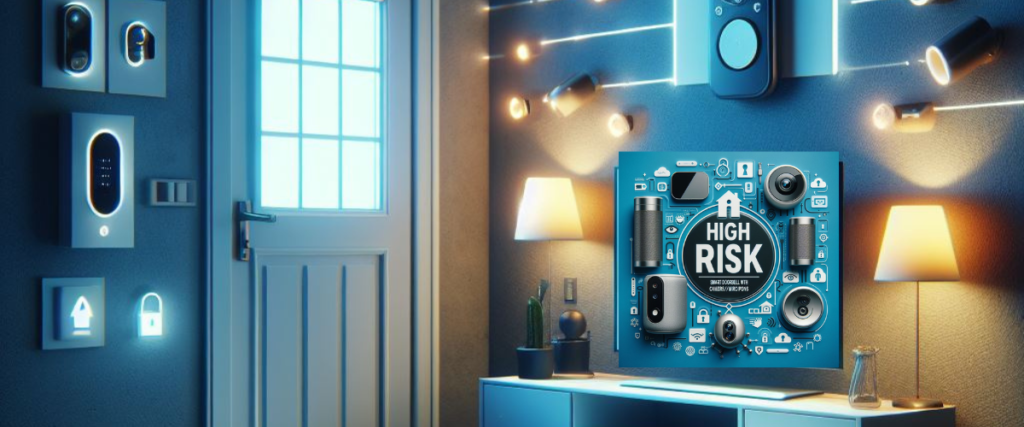
Imagine coming home to find the door unlocked, the lights off, and an expensive new TV missing. You know you didn’t authorize this… but did your smart home? Deepfakes, those disturbingly realistic fakes created with AI, are getting scarily good. This has real consequences for the world of smart homes, where a simple voice command can do everything from turning on your coffee maker to disarming your security system.
Why Smart home are Vulnerable
- Multiple Points of Entry: Smart devices (speakers, doorbells, thermostats, etc.) each increase a home network’s attack surface for hackers.
- Poor Default Security: Many devices ship with weak passwords and rarely get updated by users.
- Valuable Data: Smart homes gather information about habits and routines, attractive to attackers for theft or planning future crimes (knowing when you’re away).
Examples of Attacks
- Device Hijacking: Hackers take over cameras, speakers, etc. Used for spying, harassment, and even to make some victims think their homes are haunted.
- Ransomware: Smart devices can be locked, with owners asked to pay to regain control of their own homes.
- Botnets: Networks of compromised smart devices are used to launch large-scale attacks on websites or infrastructure. Individual owners might not even be aware.
Doxxing: Devices with poor security can be used to discover a victim’s address, aiding in real-world stalking or harassment.
Understanding the Threat
Deepfakes work by analyzing huge amounts of existing audio or video of a person. AI software learns to mimic the target’s voice, expressions, and mannerisms. Today’s smart homes heavily rely on voice recognition, often with simple commands. A deepfake of the owner’s voice could potentially trick these devices into alarming actions.

Devices at Risk
- Smart Speakers: The main point of control in many smart homes, making them prime targets.
- Smart Doorbells with Cameras/Microphones: Could be fooled into unlocking doors or letting a deepfake ‘talk its way’ past security.
- Smart Locks: Potentially opened with a deepfaked homeowner’s voice.
- Smart Hubs: Any device that centralizes control of your smart home becomes a vulnerability if voice commands are easy to mimic.
The Ease of Finding Voices
Sadly, material to train a deepfake is everywhere. Social media is full of videos and audio clips:
- Public Figures: Speeches, interviews, and the like make a wealth of potential data.
- Celebrities: Similar risks as public figures, as their voices are widely available.
- Influencers/Content Creators: People who often post videos of themselves talking are at higher risk.
- The Average Person: While it might take more effort, even regular social media activity could eventually provide enough material for a basic deepfake.
Solutions: Outsmarting the Fakes
The good news is we’re not defenseless against deepfakes. Here are some ways tech could protect smart homes, and why it’s going to be tricky:
- The Super-Secret Voice Password: Imagine your smart speaker isn’t just listening for your name but the way you say it. Tiny quirks in your voice – the rhythm, the slight pitch changes – are like a fingerprint, much harder for a deepfake to copy.
- Example: Maybe you have a habit of slightly drawing out the word “Alexa” or have a subtle upward inflection when asking a question. These become part of your unique voiceprint.
- The Voice Vault: What if your voice was stored securely, like on a blockchain – that digital record-keeping system you hear about with cryptocurrency? This could mean you get a say in how tech companies use your voice data. But getting everyone to agree on how this works and making it easy to use is a huge task.
- Example: Think of it as a super-secure lockbox only you have the key to. Instead of a physical item, the lockbox holds your voice data, and you decide which companies (and for what purposes) can access it.
- Example: Think of it as a super-secure lockbox only you have the key to. Instead of a physical item, the lockbox holds your voice data, and you decide which companies (and for what purposes) can access it.
- Robot vs. Robot: Fighting Fire with Fire: Special software could become the ‘fake voice detective,’ listening for those tell-tale signs that something’s not quite right in an audio clip. The catch? Imagine a race between a thief and a security guard – deepfakes will keep getting better, and the detection software has to keep up.
- Example: It’s like those photo-editing detectors – they can spot subtle glitches or inconsistencies that indicate a picture has been tampered with. Similar software could analyze voices for artificial ‘tells’.
- Example: It’s like those photo-editing detectors – they can spot subtle glitches or inconsistencies that indicate a picture has been tampered with. Similar software could analyze voices for artificial ‘tells’.
- Think Before You Share: So much material for deepfakes is out there on social media. Being more careful about what we post (especially those videos where we talk a lot) makes it harder for the bad guys to get the data they need. But this bumps up against how we like to use the internet, so it’s unlikely to be a perfect fix.
Conclusion
The battle against deepfakes is a constant arms race, but it’s a race we can win. Technology created this problem, and technology will play a major part in solving it. It won’t be perfect, nor easy. But with innovation and vigilance, smart homes can be both convenient and secure against voices that aren’t truly our own.